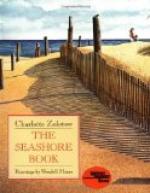Anemones are of many shapes, sizes, and colours. The loveliest of our British ones is the Plumose Anemone. It is like a carnation, and may grow to be six inches high—that is, nearly as long as this page. It is known by its shape, not by its colour. It may be any of these colours—brown, deep green, pale orange, flesh colour, cream, bright red, brick colour, lemon, or pure white.
There are many other creatures in the sea which resemble plants and are often mistaken for them. The Sea Lily (p.49) is one of the flower-like animals; it is a relative of the Starfish, living in deep water. The Sea Mat (p.59) is often found on the shore. It seems like a horny kind of weed, but is really a colony of tiny animals, each one having its own little cell to live in.
EXERCISES
1. How does the Anemone expand its “feelers”?
2. In what way does the Anemone catch the small animals on which it feeds?
3. Where is the mouth of the Anemone?
4. In what way might the Anemone be of use to its partner, the hermit crab?
LESSON VIII.
SEA-WEEDS AND SEA-GRASS
We think of weeds as useless plants which insist on growing just where they are not wanted. So it is a pity that Sea-weeds are so named, for the part they play in the sea is a useful one; and they are often beautiful, though they do not bear flowers like so many plants of the land. You see draggled heaps of them, lying on the shore where the waves have thrown them. They are best seen in their proper home, buoyed up by the water, and spreading out their broad coloured fronds, or long waving threads. There are, in many places, meadows of Sea-grass, and forests of Sea-weed! Mother Earth still has her carpet of green, even when covered by the salt water. The plants are very unlike those of the land, but, as you will see, they are of great use. We will suppose you put on a diving dress. Then you can walk out, under the water, and explore the forests of the sea.
Down by the line of low tide, before you have waded up to your knees, you find plants clinging to the rocks. They cover them with a slippery coat of green; when you turn these Sea-weeds over you find periwinkles and other animals feeding or hiding. Sea-weed makes good “cover” for the creatures of the rock-pools, who have many enemies to fear.
You notice that most of these shore weeds are green, sometimes as green as young grass. Pull up a bunch of the weed, and you find that it clings to the rocks and stones, but has no real roots. Seaweeds belong to a humble family in the world of plants, having no real roots, no flowers, and no real seeds. They can attach themselves to the stones or rocks. Along comes a great wave, and perhaps they are torn up; but this does not harm them, for they still live as they wash to and fro in the water, until they cling to another rock. Or they are thrown on the shore to die, or else to be washed back to sea by the next tide.




